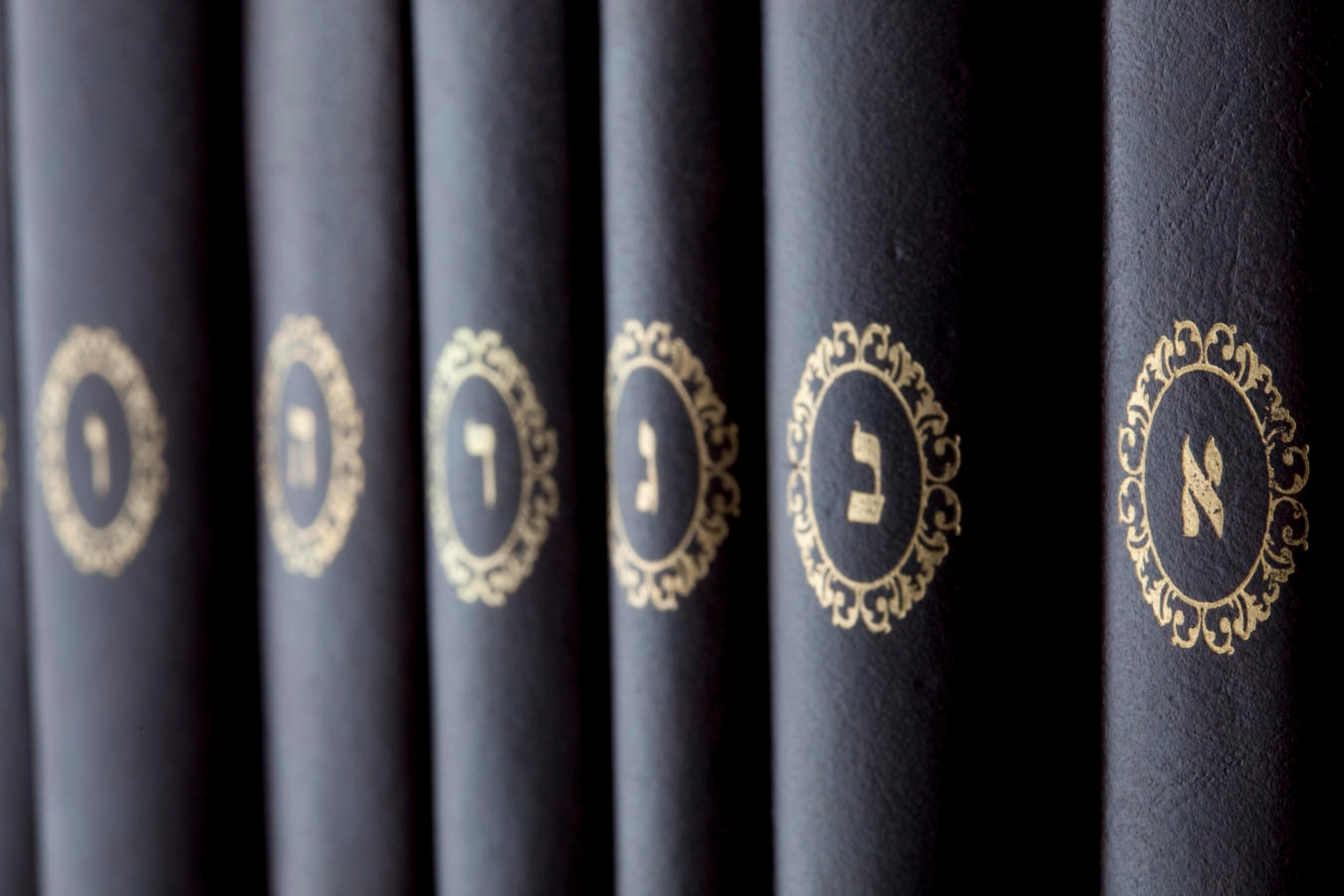The Talmud is a commentary on the Mishnah, a third century compendium of Jewish law. It’s mostly composed of the quoted traditions of hundreds of rabbis from the first to fifth centuries, organized into topical discussions that frequently proceed associatively, rather than systematically. It’s written in Aramaic, but quotes many Hebrew text and the two languages are intertwined throughout. When it quotes the Bible, it often does so partially, assuming the reader can complete a biblical verse from memory. In short, the Talmud is text written by insiders, for insiders. Breaking in means getting straight on the Talmud’s basic vocabulary. These are common words associated with the Talmud that you should know:
Aggadah – Pronounced Ah-gah-DAH, this word literally means “telling” and is a catch-all referring to the non-legal (e.g. non-halachic) writings in the Talmud and other classical rabbinic literature. It includes biblical interpretation, narratives and folklore, parables, historical anecdotes, practical advice, and moral wisdom.
Amora – Pronounced ah-MORE-ah (plural Amoraim) this word refers to rabbis in both the Land of Israel and Babylonia in the third through fifth centuries who are quoted in the Gemara.
Bavli – Pronounced BAHV-lee, this refers to the version of the Talmud produced in Babylonia (in English, the “Babylonian Talmud”). It is one of two Talmuds (the other is the Yerushalmi), and it is the more complete, the more studied, and the more sacred of the two. When people refer simply to “The Talmud” they usually mean the Bavli. The Bavli is the foundational text of Judaism.
With your help, My Jewish Learning can provide endless opportunities for learning, connection and discovery.
Beit Midrash – Literally “house of study,” the beit midrash is the place where rabbis come together to learn, lecture, and debate.
Beraita – Pronounced BRY-tah, this refers to a teaching by a Tanna (first-third century rabbi) that is not in the Mishnah. Many though not all beraitas are collected in the Tosefta.
Gemara – Pronounced ge-MAH-rah, this is the bulk of the text of the Talmud and it is the sum of all the various commentaries on the Mishnah. Sometimes the word “Talmud” refers to the Gemara alone, though it usually refers to the combination of the Mishnah and the Gemara.
Geonim — Singular: Gaon. Pronounced: geh-OH-neem. The geonim were the heads of the talmudic academies in Babylonia, situated in Sura and Pumbedita, from the time that the Talmud was completed (late 6th century) until the 10th century. In their day, they were the highest authorities on Jewish law. They were also among the earliest talmudic commentators, and authored the first siddurim. The most famous is Saadiah Gaon.
Gezerah Shavah – Pronounced get-ZAY-reh SHAH-vah, this literally means “equivalent ruling.” It refers to an argument that a rule that applies in one case applies to another based on an equivalence between the two cases, either similar circumstances or similar language.
Halacha — Pronounced hah-lah-KHAH, from the Hebrew word for “walking” or “path,” is the rabbinic interpretation of Jewish law.
Havruta – Pronounced khav-ROO-tah, this word refers to a partner with whom one studies Talmud.
Kal va’homer – Pronounced kahl vah-KHOH-mare, this literally means “easy and hard” or “lenient and strict.” It refers to deductive arguments in which a less obvious case is used to prove a more obvious one, or a less stringent case is used to prove a more stringent one.
Machloket – Pronounced makh-LO-ket, this means dispute or argument and refers to a legal disagreement between sages in the Talmud.
Massechet – Pronounced mah-SEH-khet, this word means “tractate.” The Babylonian Talmud is composed of 63 massechets.
Mishnah/mishnah – Pronounced MISH-nah, the Mishnah is a third-century compilation of rabbinic law. It is the core of the Talmud, which is a collection of commentaries on the Mishnah. The world “mishnah” (small “m”) refers to a single teaching in the Mishnah.
Rashi – Rashi, Rabbi Solomon ben Isaac, was one of the greatest expositors and commentators on the Talmud. He lived in 11th-century France and also wrote a classic commentary on the Bible.
Rishonim — Singular: rishon. Pronounced: ree-SHONE-eem. The rishonim were the leading rabbis between the 11th and 15th centuries CE, coming after the geonim and before the creation of the most significant talmudic law code, the Shulchan Aruch. Famous rishonim include Rashi, Nahmanides, Moses Maimonides, Yehuda HaLevy and the Tosfaot, among many others.
Shas – Pronounced SHAHS, this is actually an acronym for the Hebrew term shisha sidrei, meaning “six orders” referring to the six orders of the Mishnah. The term is used, however, as a shorthand for “Talmud.”
Siyyum – Pronounced see-YOOM, this is a celebration that one makes when one has completed a certain defined set of study, often one massechet, or tractate, of the Talmud.
Sugya – Pronounced SOOG-ya, this refers to a set of arguments in the Talmud that together discuss a particular issue or mishnah. A sugya is a kind of sustained argument on a subject. These are the building blocks of the Talmud (almost like unmarked chapters).
Tanna – Pronounced TAH-nah (plural Tannaim), the Tannaim were teachers who flourished in the Land of Israel in the first two centuries CE and whose views appear in the Mishnah.
Tosafot – A set of commentaries to the Talmud that add to Rashi’s commentary, primarily composed by his grandchildren.
Tosefta – Pronounced toe-SEF-tah, this refers to a collection of Tannaitic teachings (from first–third century rabbis) that follows the same structure as the Mishnah. The teachings that appear in the Tosefta are called beraitas.
Yerushalmi – Pronounced yeh-roo-SHAHL-mee, this refers to the version of the Talmud produced in the Land of Israel, and it is less complete, less studied, and less authoritative in Jewish tradition, though still holy.
And then enhance your Talmud study with our unique Talmud-themed book club, Off the Daf. Featuring fiction and non-fiction works and conversations with the authors. Learn more and sign up here.



